DENTAL SOLUTIONS

JUL - SEP 2023
EXCLUSIVE ONLINE BENEFITS
EXCLUSIVE ONLINE BENEFITS
TAKE ADVANTAGE OF THESE EXCLUSIVE BENEFITS
TAKE ADVANTAGE OF THESE EXCLUSIVE BENEFITS
• Speed up your consumable ordering
• Speed up your consumable ordering
• Speed up your consumable ordering
• Speed up your consumable ordering
• Select from over 18,000 products
• Select from over 18,000 products
• Select from over 30,000 products
• Select from over 30,000 products
• Track & Trace deliveries
• Track & Trace deliveries
• Track & Trace deliveries
• Track & Trace deliveries
• Ordering templates to save time & money
• Ordering templates to save time & money
• Ordering templates to save time & money
• Ordering templates to save time & money
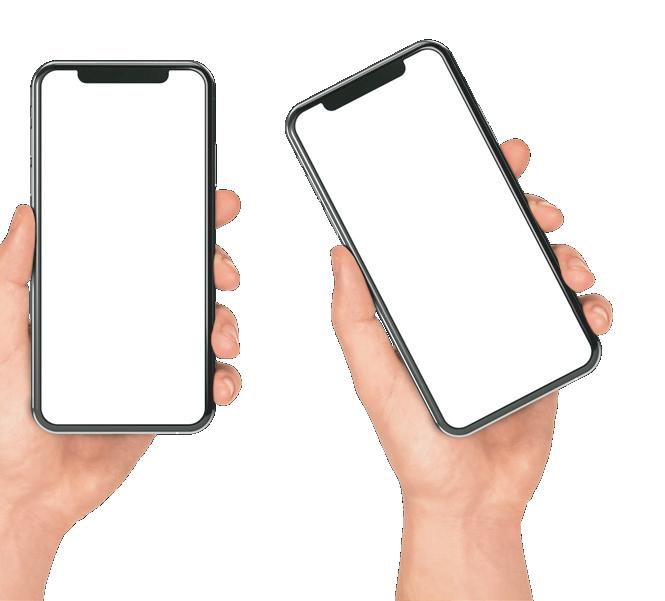

• View your backorder status
• View your backorder status
• View your backorder status
• View your backorder status
• Pay your account quickly Online
• Pay your account quickly Online
• Pay your account quickly Online
• Pay your account quickly Online
•Online Live Chat - to resolve any questions
• Inventory Management Solutions
• Inventory Management Solutions
•Online Live Chat - to resolve any questions
•Online Live Chat - to resolve any questions
•Online Live Chat - to resolve any questions
henryschein.co.nz
henry schein.co.nz
HENRY SCHEI N. COM
HENRY SCHEI N. COM
SCHEINING PRICES MAY
SCHEINING PRICES MAY
YOUR GO - TO SITE FOR EDUCATIONAL CONTENT AND COURSES
YOUR GO - TO SITE FOR EDUCATIONAL CONTENT AND COURSES
• Webinars
• Webinars
Exclusive online only promotions every month
Exclusive online only promotions every month
• Podcast
• Podcast
• Clinical Videos
• Clinical Videos
• Henry Schein TV
• Henry Schein TV
• Clinical Articles & News
• Clinical Articles & News
• Latest In-Person Events & Courses
• Latest In-Person Events & Courses
DENTALEDUCATIONHUB.CO.NZ
DENTALEDUCATIONHUB.CO.NZ









Clinical content from leading global dental manufacturers updated weekly
Clinical content from leading global dental manufacturers updated weekly

02 0800 808 855
NEW ZEALAND’S LARGEST
AUSTRALIA’S LARGEST ONLINE STORE FOR
NEW ZEALAND’S LARGEST
AUSTRALIA’S LARGEST ONLINE STORE FOR
ONLINE
NEW ZEALAND’S LARGEST DENTAL ONLINE STORE



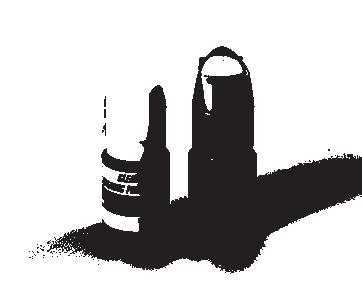
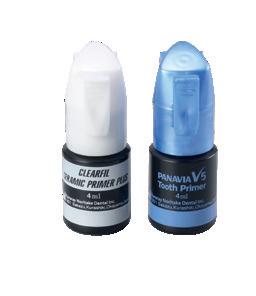

03 henryschein.co.nz 08 Panavia Veneer LC COSMETIC & RESTORATIVE ENDODONTICS 08 19 NEW PRODUCT SPOTLIGHT CAD / CAM 04 06 EQUIPMENT INFECTION CONTROL 20 26 INSTRUMENTS PREVENTATIVE 36 38 Equipment is in our DNA 24-25
19
HySolate Black Rubber Dam
NEW PRODUCT SPOTLIGHT
Liquid Pyroneg Concentrate
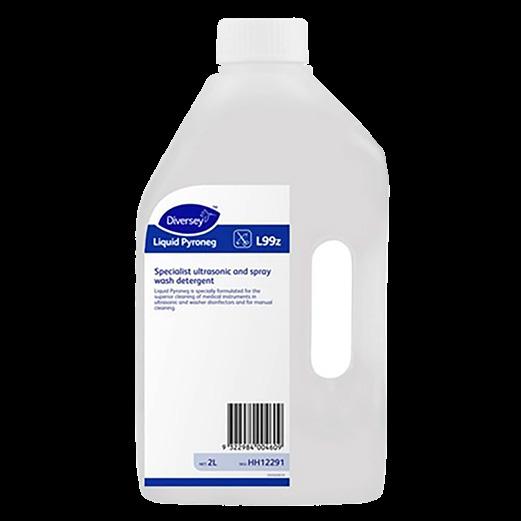
Specially formulated for the superior cleaning of instruments in ultrasonic cleaners, washer disinfectors and manual cleaning.
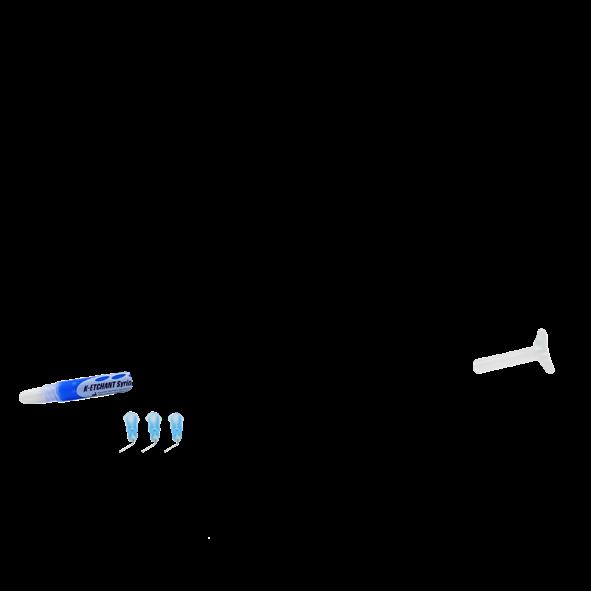
Kuraray Panavia Veneer LC Cement
PANAVIA™ Veneer LC is a light-cure, resin cement with excellent colour stability, high wear resistance with ample working time and a one second tack-cure for fast and easy clean up. For the placement of veneers the new PANAVIA™ Veneer LC is precisely what you need.
04 0800 808 855
NEW PRODUCT SPOTLIGHT
STRATA-G from Garrison
Now faster and more predictable
Reliable, tight contacts. Drawn-wire nickel titanium plus PEEK produces consistent separating pressure longer. Easier, more predictable contours. Marginal ridge enhancements built into the matrix bands AND rings help provide that finishing flair.
Faster, less frustrating Class IIs. The Strata-G™ rings, bands and wedges combine for a 270° Seal™ for ultimate flash control. The rings won’t spring off the tooth, and the amazing Wide Preparation ring makes tough wide preps no problem.

HySolate from Coltene Hygienic is now HySolate
For decades COLTENE has produced a comprehensive portfolio of high-quality dental dam, clamps, and accessories. To reduce your risk of gaining a hypersensitivity to latex, all our standard latex dental dams from Hygenic have been replaced with the improved low protein and powder free latex dams named HySolate.
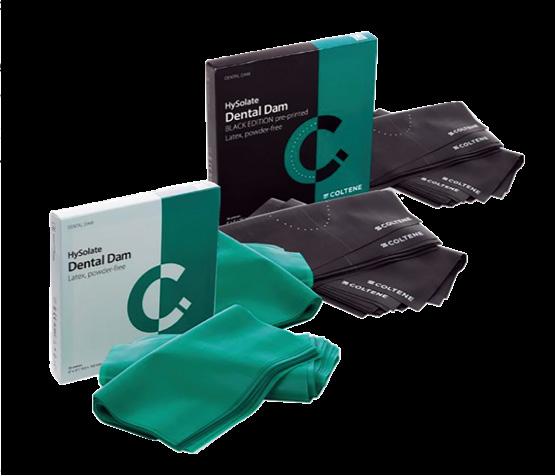
05 henryschein.co.nz
THE POWER COUPLE
SAME-DAY DENTISTRY. UNPARALLELED PERFECTION.
THE 4-AXIS MILLING MACHINE FOR WET MACHINING RESTORATIONS IN MERE MINUTES.
Integrated workflow with a single interface, and excellent same-day restorations for the patient in ultra HD.
The Z4 creates high-quality restorations in mere minutes.
Combined with the TRIOS 5 Wireless, which is 3Shapes smallest and lightest scanner to date, is perfectly balanced to fit perfectly in the clinician’s hand, makes it easier than ever to go digital.
TRIOS 5 Wireless delivers an unprecedented level of scanning simplicity.
An LED ring and haptic sensory feedback guide users while they scan to make digital impression taking smoother and faster than ever.
And now with ScanAssist technology, which minimises misalignment and distortion in 3D models, users can scan their patients in any direction they want – just create the scan path that works best for them.
3Shape provides an intuitive user interface from scanning with the TRIOS intraoral scanner to designing the restoration, then milling with the Z4 in a completely integrated workflow.

WHY CHOOSE THE 3SHAPE TRIOS 5 SCANNER AND THE VHF MILL THROUGH HENRY SCHEIN?
Affordability – Highest quality equipment that pays for its investment in no time
Trusted Connection – Validated Trusted Connection with 3Shape Trios Design Studio and VHF
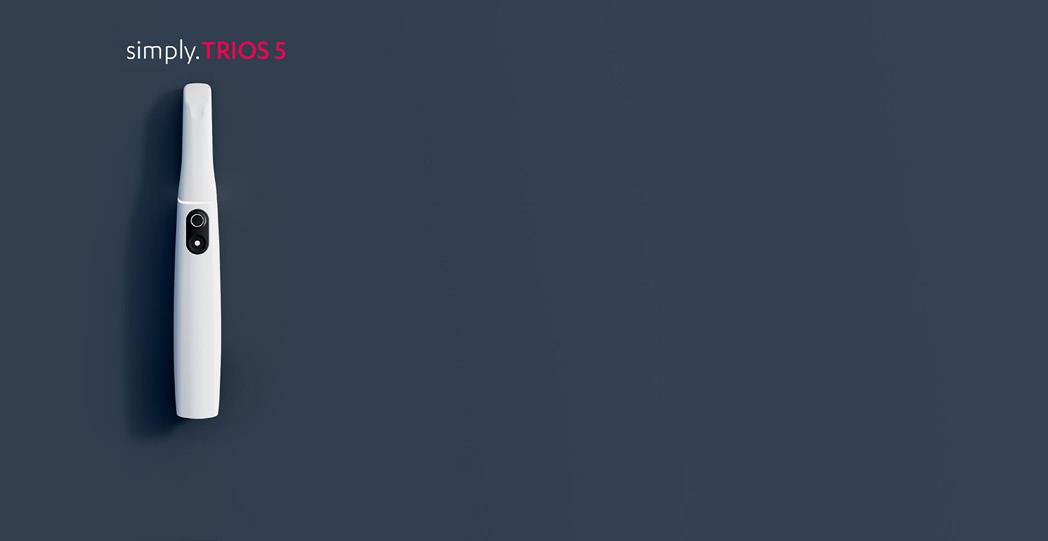
Flexibility of Material Choice – Composites, Glass Ceramics, Prefabricated Titanium Abutments, PMMA, Zirconium Oxide
Technical Support – Henry Schein provide support from our team of in-house specialist factory trained technicians.
06 0800 808 855 CAD / CAM
HIGHEST PRECISION
Milling and grinding in Ultra-HD
3 micron repetition accuracy
COMPLETE INDEPENDENCE
38 block materials from 20 manufacturers
800+ prefab titanium abutment blanks from 11 manufactureres
Validated with all established scanners and design software
Fully integrated workflow with Trios Design Studio (3Shape) and Exocad ChairsideCAD
Integrated PC with touch screen and WI-FI. No laptop necessary
Built in compressed air. No compressor needed.
FASTEST PRODUCTION
Restorations in under 10 minutes
2-second block insertion
100,000 RPM electrical high frequency spindle
EXTREMELY ECONOMICAL
Clear water. No additives necessary
Automatic changer for 6 tools

Self-opening working chamber door and drawer
Easy to learn. Easy to operate
CAM software included
Tool starter set included
07 henryschein.co.nz CAD / CAM
CHOOSE PANAVIA™ VENEER LC
AND
VENEER CEMENTATION BECOMES A SUCCESS
Prosthodontic treatment concepts have evolved over the past decades. While some time ago, porcelainfused-to-metal crowns and bridges were placed wherever a defect was too large for a direct restoration, the current trend is toward less invasive therapies with highly aesthetic, tooth-coloured materials.

These modern treatment concepts can lead to predictable outcomes when a high-performance resin cement system is used that establishes a durably strong bond to tooth structure on one side and the restoration on the other. The reason is that less invasive often means that restorations have minimal or no retentive elements and extremely thin walls, and a strong chemical bond is a mechanism that holds them in place over time. Depending on the type of restoration and area in the mouth, aesthetic properties of the cementation system are also extremely important, as the typically highly translucent, thin restorations tend to reveal the appearance of the structures underneath to a certain extent.
Universal cements
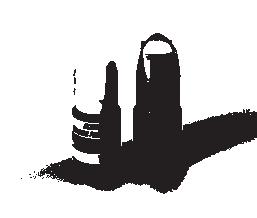
In the context of striving toward the streamlining of clinical procedures in restorative dentistry, several manufacturers have developed resin cements that work with fewer components and are suitable for a large number of indications. PANAVIA™ SA Cement Universal is a popular example. The self-adhesive, dual-cure resin cement is the only product of its category that works as a standalone solution even on glass ceramics (without the need for a separate primer).

The need for specialists
There are specific clinical situations, however, that require more working time than a dual-cure resin cement can offer. This is the case whenever multiple non-retentive restorations are to be placed simultaneously, a technique that is recommended for veneers. The greatest benefits of placing the thin and highly aesthetic restorations at once lie in the proper positioning of the restorations and in the minimized risk of contamination: When the veneers are placed one after the other, a slightly malpositioned and already fixed veneer might hinder proper positioning of the adjacent restorations and haemorrhage occurring in the context of excess cement removal or finishing of the margin might contaminate the working field. When all veneers are placed simultaneously, repositioning is possible, while excess removal and polishing are accomplished in a moment when blood and debris will no longer endanger the integrity of the restorations, which increases the security during the whole procedure. This task is best fulfilled by a light-curing veneer specialist.
Required properties of veneers cements
Undoubtedly, the key feature of a specialist resin cement system is a long working time sufficient for simultaneous cementation of multiple restorations.
In addition, its consistency and handling properties are also important as they can help users overcome the challenge of accurate positioning and reduce the time and effort involved in veneer placement. And finally, the system needs to provide excellent bond strength over time and support long-lasting aesthetics, properties valuable for every kind of resin cement, but the latter being particularly important for thin restorations in the aesthetic zone. Luckily, PANAVIA™ Veneer LC offers all those features.
The system consists of PANAVIA™ V5 Tooth Primer that establishes a strong bond to enamel and dentine, PANAVIA™ Veneer LC Paste as the cement and the CLEARFIL™ CERAMIC PRIMER PLUS that has been part of PANAVIA™ V5 cementation system. The latter is responsible for a high bond strength to all types of restorative materials.

Mastering the working time challenge
The light-curing cement paste offers a long working time of 200 seconds* due to its excellent stability under ambient light. As a consequence, dental practitioners may place multiple veneers simultaneously without having to race against setting. Polymerization may be started whenever the user is ready for it. The one-component self-etching tooth primer (PANAVIA™ V5 Tooth Primer) does not contain any photo initiators and does not cure alone. When applied, it etches and penetrates into the tooth surface for 20 seconds and is ready to bond strongly to PANAVIA™ Veneer LC Paste. The integrated touchcure technology is the key feature safeguarding a high bond strength to tooth structure without shortening the working time.
Providing for precise placement
In order to streamline the clinical seating procedure from cement application to polishing, PANAVIA™ Veneer LC has been equipped with a set of well-balanced handling properties. Newly developed spherical silica fillers in the cement provide that it stays put where applied, but flows well when the veneer is seated on the tooth – for easy placement without drifting or sagging. During application across the intaglio surface, the resin cement does not stick to the application tip, a property achieved by the addition of nanocluster filler technology. The special design of the syringe’s application tip optimises control over the amount of cement applied.
And last but not least, excess cement may be easily removed in one piece using an explorer after a one-second tack-cure, while polishing of the margins is quickly accomplished.

08 0800 808 855
COSMETIC & RESTORATIVE
* Not a trademark of KURARAY CO., LTD
Hiding the margins
Being extremely thin, highly translucent and mainly used to restore teeth in the exposed anterior region of the maxilla, veneers have to be placed with a cement that is and remains undetectable underneath the restoration and at its margins.
PANAVIA™ Veneer LC is available in four highly aesthetic shades with matching try-in pastes, so that a precise shade match with the restoration can be achieved and verified in the patient’s mouth. Additional features contributing to undetectable margins are the resin cement’s flowability and low film thickness: They enable users to easily produce an evenly distributed, thin cement layer for aesthetic outcomes.
For those afraid that coffee, tea, acidic drinks or constant tooth brushing might reveal the margins over time, there is good news as well: PANAVIA™ Veneer LC offers a high polish retention and colour stability over time. The well-balanced formulation and the touch-cure technology are responsible for this resistance to discolouration
Trusted expertise
All these beneficial features make PANAVIA™ Veneer LC worth testing. Additional arguments are the fact that its primers are tried and tested components of the highly popular PANAVIA™ V5 system and that Kuraray Noritake Dental Inc. is a proven expert on adhesive products.
Kuraray Noritake Dental developed the original MDP Monomer in 1981 and introduced the first adhesive resin cement containing this monomer in 1983. Since then, the company has improved existing formulations and technologies that ultimately resulted in the current line-up of cementation solutions for every need and indication.
Spherical silica filler

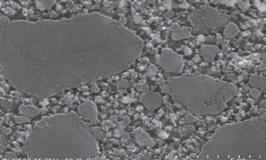


Flow and formability (not runny) combined
Excellent polishability & gloss durability
Nano Cluster Filler
Reduction of stringing (Good handling)
Measured at 15 kV acceleration voltage and 10000 magnification.
Source: Kuraray Noritake Dental Inc.
Excellent gloss retention is one of the properties providing for undetectable margins over time.
TEST CONDITIONS: Specimen ø10mm, thickness 2mm. After smoothing the surface with water-resistant abrasive paper of #1000 to #2500, final polishing with lapping film.
• Initial value (measure the gloss level after polishing*)
• Toothbrush wear (measured after 40,000 strokes with 250g load, 30 strokes/minute, 10 wt% toothpaste*)
* Measured with a glossmeter VG 2000 (Nippon Denshoku Kogyo) at an angle of 60°
NOTE: Values may vary depending on measuring conditions.
SOURCE: Kuraray Noritake Dental Inc.
09
henryschein.co.nz
5 μm 5 μm 5 μm
COSMETIC & RESTORATIVE New filler technology
PANAVIA™ Veneer LC Paste RelyX Veneer (3M)*
Valiolink Esthetic LC (Ivoclar)*
10,000 20,000 0 40,000 TOOTHBRUSH WEAR View Online
Gloss
retention PANAVIA™ Veneer LC (%)
REPAIR TECHNIQUE GUIDE
YOUR STEP-BY-STEP TECHNIQUE
From metal-based, composite, zircona, glass or hybrid ceramic, we have your restorations covered with this step-by-step repair technique guide. Whether your case involves tooth structure— or not, learn how GC’s range of restorative products are used to achieve optimal results.
Metal-Based Indirect Restorations (precious and non-precious) without involvement of tooth structure.



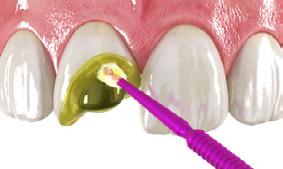
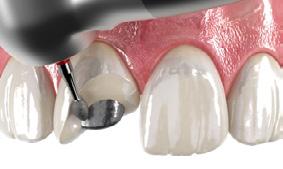

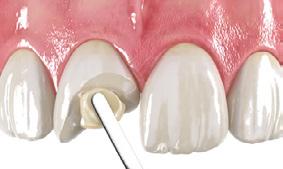

LIGHT CURING TIME OF G-PREMIO BOND DISTANCE FROM LIGHT GUIDE TIP
Light curing unit <10mm >10mm
Halogen / LED (700 mW/cm²) 10 sec 20 sec
High power LED (>1200 mW/cm²) 5 sec 10 sec
10 0800 808 855
8. Final result.
7. Build-up with composite (e.g. G-ænial or Essentia) and light-cure each layer.
2. Apply G-Multi PRIMER only onto the ceramic surface to be repaired. Dry.
1. Roughen the bonding surface with a coarse diamond bur. Rinse and dry.
3. Apply G-Premio BOND to all bonding surfaces. Wait 10 sec.
5. Light cure following below guidelines.
4. Dry with maximum air pressure for 5 sec.
6. Apply Essentia Masking Liner onto the metal surface and light cure each layer for 20 sec.
COSMETIC & RESTORATIVE
Intra-oral repair of indirect restorations made of glass-ceramics, zirconia, alumina & hybrid ceramics (e.g. CERASMART270) with involvement of tooth structure


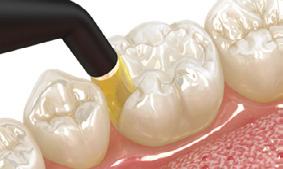



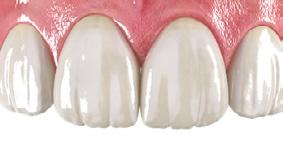
2. Apply G-Multi PRIMER only onto the surface to be repaired*. Dry. *In case of monolothic zirconia or alumina, the use of Ceramic Primer II or G-Multi PRIMER is not needed.
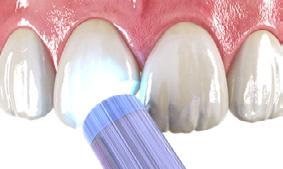

3. Apply G-Premio BOND to all bonding surfaces (including tooth structure). Wait 10 sec.

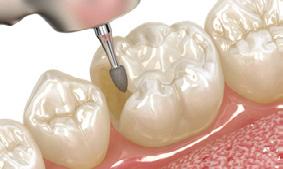
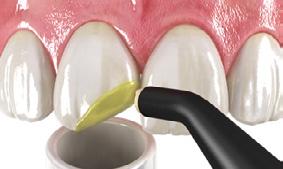


View the Repair Technique guide
Intra-oral repair of composite restorations without involvement of tooth structure
11
henryschein.co.nz
2. Apply G-Premio BOND to bonding surfaces (including tooth structure). Wait 10 sec.
1. Roughen the bonding surface with a coarse diamond bur. Rinse and dry.
3. Dry with maximum air pressure for 5 sec.
5. Build-up with composite (e.g.G-ænial or Essentia) and light-cure each layer.
4. Light cure following above guidelines.
COSMETIC & RESTORATIVE
6. Final result.
1. Roughen the bonding surface with a coarse diamond bur. Rinse and dry.
5. Light cure following below guidelines.
4. Dry with maximum air pressure for 5 sec.
6. Build-up with composite (e.g. G-ænial or Essentia) and light-cure each layer.
7. Final result.
Light
Halogen / LED (700 mW/cm²) 10 sec 20 sec High power LED (>1200 mW/cm²) 5 sec 10 sec
LIGHT CURING TIME OF G-PREMIO BOND DISTANCE FROM LIGHT GUIDE TIP
curing unit <10mm >10mm
ALL-IN-ONE SOLUTION FOR LUTING AND REPAIR
G-Multi PRIMER is used for the pretreatment of restorations before luting with G-CEM LinkForce or G-CEM Veneer and can also be used for intraoral repairs. It contains three different chemical agents to ensure a perfect adhesion to all types of restorations.

Indirect restorations made of glass-ceramics, zirconia, alumina & hybrid ceramics (e.g. CERASMART) without involvement of tooth structure
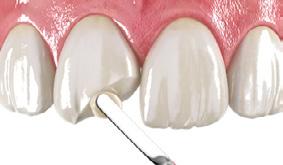



1. Roughen the bonding surface with a coarse diamond bur. Rinse and dry.
2. Apply G-Multi PRIMER only onto the surface to be repaired*. Dry. *In case of monolothic zirconia or alumina, the use of Ceramic Primer II or G-Multi PRIMER is not needed.



3. Apply G-Premio BOND to all bonding surfaces. Wait 10 sec.
4. Dry with maximum air pressure for 5 sec.
5. Light cure following below guidelines.
LIGHT CURING TIME OF G-PREMIO BOND DISTANCE FROM LIGHT GUIDE TIP
6. Build-up with composite (e.g. G-ænial or Essentia) and light-cure each layer.
12 0800 808 855
COSMETIC & RESTORATIVE
7. Final result.
Light curing unit <10mm
Halogen / LED (700 mW/cm²) 10 sec 20 sec High power LED (>1200 mW/cm²) 5 sec 10 sec
>10mm
View the G-Multi Primer brochure
G-AENIAL UNIVERSAL INJECTABLE



Injection Moulding Technique
As restorative dentists, the interplay between achieving the desired aesthetics but also conserving tooth structure is very important to consider. This case illuminated the benefit of composite injectables for the Dahl technique as part of one’s armamentarium to conservatively treat localised tooth wear. This case involved addressing the aesthetic concerns whilst also seeking to conservatively manage localised tooth surface loss.
Initial Presentation
The alternate teeth being injected with the first stent had the existing composite resin veneers removed and the tooth surfaces were air abraded with 27 micron.aluminium oxide. Matrix bands were used to protect the adjacent teeth

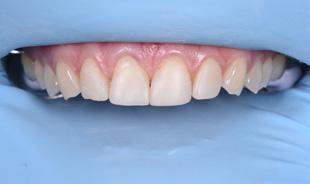

Alternate teeth were wrapped with Teflon tape (12,21,23). The non-PFTE wrapped teeth were then etched with 37% phosphoric acid and thoroughly washed. G-Premio BOND was applied and light cured Using G-aenial Universal Injectable shade B1 alternate teeth were injected through the exaclear stent


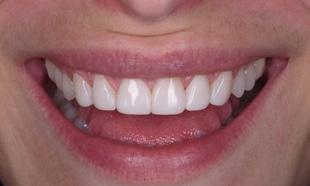
2 month review showcasing seamless integration of the G-aenial Universal

13 henryschein.co.nz
Images courtesy of Dr Selena Liu, Sydney
The alternate teeth 12, 21 and 23 were etched and bonded; The second exaclear stent was placed over the teeth and the remaining teeth injected using G-aenial Universal Injectable shade B1
Post Operative view after removal of excess composite resin and finishing and polishing
Injectable
Now available in Unitips COSMETIC & RESTORATIVE Transform the way you work Start injecting with our strongest direct restorative ever* G-ænial Universal Injectable
View the G-aenial Universal Injectable brochure
LOOKING FOR BLEACH SHADES?
FOR DIRECT AND INDIRECT RESTORATIONS


GC HAS YOU COVERED
DIRECT COMPOSITE BLEACH SHADES
14 0800 808 855 COSMETIC & RESTORATIVE
G-ænial™ Anterior XBW, BW
Gradia Direct X BW
G-ænial™ Universal Flo BW
Gradia Direct Anterior XBW, BW
G-ænial™ Universal Injectable XBW, BW
G-ænial™ A’CHORD BW, BOW
TIMES
HAVE
CHANGED
AND SO HAS THE DEMAND FOR LIGHTER SHADES
INDIRECT BLEACH SHADES

Bleach
Block Bleach Shade Coming Soon


TALK TO A GC SPECIALIST TODAY and discover all our Bleach Shade Options in Composite, Provisional, Cementing Materials and CAD-CAM Blocks


15 henryschein.co.nz COSMETIC & RESTORATIVE
TEMPSMART BW Syringe
G-CEM Link Force Syringe Bleach
LiSi Initial
G-CEM Veneer Syringe Bleach
CeraSmart270 CAD-CAM Block Bleach
DIRECT, COMPLEX REINFORCEMENT
OF ENDODONTICALLY TREATED, PERICERVICAL DENTINE WITH SUPERCOMPOSITE FOR MOLAR PRESERVATION
A 65-year-old Canadian dentist presented in my practice with fourth-degree root caries in tooth 26 (upper left first molar).
A distal-occlusal restoration was placed, also extending into the root region. The pulp was not opened during the excavation. Ten weeks later, after a sudden progression of the symptoms, the decision was taken to perform a root canal treatment, and the patient was referred to an endodontist.
Once the endodontic treatment and temporary restoration were complete, the patient presented in the practice again for further treatment (Fig. 1).
The patient requested a restoration made of a composite with optimal mechanical properties so that the coronal structure is stabilised, the cusps covered and thus reinforced, and as much of the pericervical dentine as possible is preserved, as this factor ultimately determines the fracture resistance and prognosis of a tooth.
In order to achieve the layer thickness required for this type of restoration, an occlusal reduction of 2 mm is required to ensure the longevity of the composite restoration. This was done by firstly producing grooves as depth markings (Fig. 2), then removing the temporary restoration and the old amalgam restorations and finally reducing the occlusal surface (Fig. 3+4).
To seal the pulp chamber, a layer of glass ionomer restorative material was applied as a fluoride- releasing, protective liner. Then just a shoulder measuring 1 mm in depth and 1.5 mm across was prepared all around the tooth (Fig. 5).
This method allowed preservation of all the remaining pericervical dentine, with the result that the tooth still possesses high fracture resistance even after endodontic treatment.
Following micro air abrasion with 27 µm aluminium oxide, the tooth was etched for 15 seconds with 33% orthophosporic acid so as to create an even larger bonding surface. Futurabond U (VOCO) was then applied and massaged in for 20 seconds so as to achieve maximum wetting and consequently adhesion of the filling.
Technology
The buccal and lingual walls of the cusps were sculpted using the nanohybrid composite GrandioSO (VOCO) in A3 shade and placed by hand first of all, with the height of the neighbouring cusps being used as a reference (Fig. 6). Figure 7 shows the occlusal view of the initial buccal and lingual cusps and the preliminary formation of the ridge between the distobuccal and mesiopalatal cusps, which will later be angled. The marginal ridges are formed with a sectional matrix system only when the buccal and lingual walls of the cusps are finished. A class I restoration is produced (Fig. 8). The mesiobuccal cusp is finished and the fissures are given a contrasting shade (Fig. 9).
The restoration is completed with successive cusp formation on the central mesial, mesiopalatal and distopalatal sides (Fig. 10). Finally, occlusal adaptations are performed (Fig. 11) before the restoration with its five cusps is polished and finished (Fig. 12).
Material discussion
Selection of bonding agent: Futurabond U (VOCO). This eighth-generation bonding agent is characterised by outstanding shear strength and is suitable for a range of applications: total etch, selective etch and self-etch. It has dual-curing properties, meaning that no separate activator needs to be added for dark curing (self-cure). Even after thermocycling, the bond to enamel is significantly better than with comparable products and achieves a remarkable 33.8 MPa in the thermocyclic self-etch technique. The bond to dentine is also notable, and even in the thermocyclic self-etch technique is a full 8 MPa higher than with a conventional alternative.
Selection of composite: GrandioSO (VOCO), shade A3. GrandioSO was selected for its excellent flexural strength of 187 MPa, which is considerably higher than that of dentine (165.6 MPa). Even after thermocycling, it is very biomimetic, at 158 MPa. As the material is employed in a region subject to very high loads, its
16 0800 808 855
COSMETIC & RESTORATIVE
compressive strength is decisive for avoiding cohesive compression shear fractures. At 439 MPa, it is far higher than that of enamel (384 MPa) and also dentine (297 MPa). The microhardness of the surface and abrasion resistance are two further factors which ensure that the surface remains intact for as long as possible. The surface hardness of GrandioSO is almost twice as high as that of the other composites tested (Behrend, D., University of Rostock, 2010), and at 211 MHV is very close to natural enamel, which has a surface hardness of 350-450 MHV.
It proved possible to use just a single shade (A3) for the entire restoration, as its properties and the high filler content permit an outstanding chameleon effect.
Conclusion
The end result is an extraordinarily stable, direct acrylic restoration, which protects the underlying, damaged tooth structure and, thanks to the strong bond and its physical properties, possesses considerable durability. In addition, it enables great aesthetics.


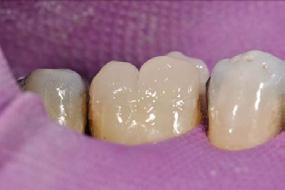





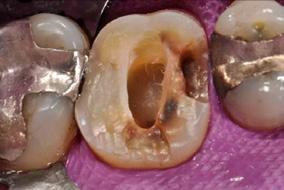
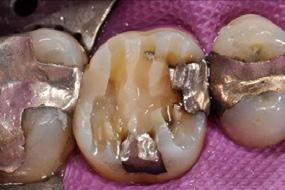
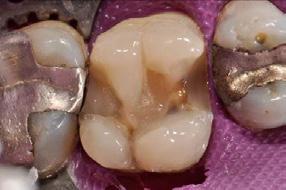


17 henryschein.co.nz
Fig. 7: Occlusal view
Fig. 8: Marginal ridge formation after finishing of the buccal and lingual walls of the cusps
Fig. 9: Production of the mesiobuccal cusp and contrasting shade for the fissure system
Fig. 1: Preoperative situation following completed endodontic treatment
Fig. 2: Production of the grooves
Fig. 3: Removal of the old restorations and cusp reduction
Fig. 10: Finishing of the restoration
Fig. 11: Occlusal adaptations
Fig. 12: Polished restoration
Fig. 4: Application of a layer of glass ionomer restorative material as a fluoride-releasing cavity liner
Fig. 5: Creation of a broad shoulder as a measure for the retention shape
Fig. 6: Sculpting of the buccal and lingual walls of the cusps
View on the Henry Schein Web Shop
COSMETIC & RESTORATIVE
DR CLARENCE TAM HBSc, DDS
Reliable, tight contacts
Reliable, tight contacts
Now faster and more predictable!
270º Seal™ for control!
270º Seal™ for control!
Easier, more predictable contours
Easier, more predictable contours
Faster, less frustrating Class IIs
Faster, less frustrating Class IIs


Drawn-wire nickel titanium plus PEEK produces consistent separating pressure longer!
Drawn-wire nickel titanium plus PEEK produces consistent separating pressure longer!
Marginal ridge enhancements built into the matrix bands AND rings help provide that
Marginal ridge enhancements built into the matrix bands AND rings help provide that
The Strata-G™ rings, bands and wedges combine for a 270º Seal™
The Strata-G™ rings, bands and wedges combine for a 270º Seal™

The rings won’t spring o the tooth, and the amazing Wide Preparation ring makes tough wide preps no problem.
The rings won’t spring o the tooth, and the amazing Wide Preparation ring makes tough wide preps no problem.

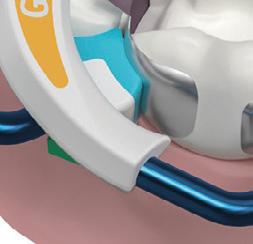

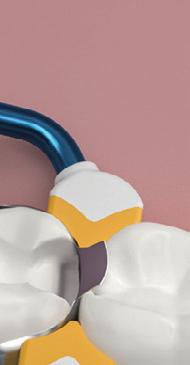
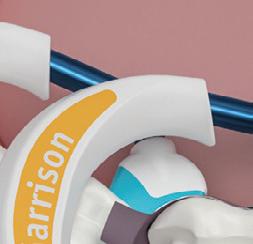
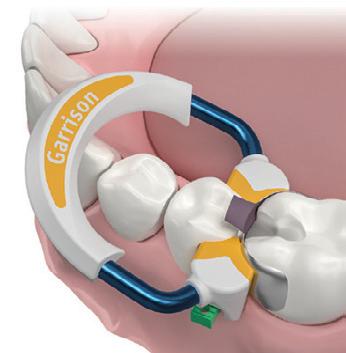
Garrison® sectional matrix systems are the standard of care.
Garrison® sectional matrix systems are the standard of care.
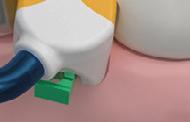

1 Short Ring (blue)
1 Short Ring (blue)
1 Tall Ring (orange)
1 Tall Ring (orange)

1 Wide Prep Ring (green)
1 Wide Prep Ring (green)

50 Assorted Matrix Bands
50 Assorted Matrix Bands
50 Assorted Firm Matrix Bands 10 VariStrips
50 Assorted Firm Matrix Bands 10 VariStrips
80 Assorted Ultra-Adaptive Wedges
80 Assorted Ultra-Adaptive Wedges
5 Deep Margin Elevation Bands
5 Deep Margin Elevation Bands
1 Ring Placement Forceps
1 Ring Placement Forceps
GA1-SG-KSH-10
GA1-SG-KSH-10
View the range
18 0800 808 855
t he a l l N E W
Now faster and more predictable!
t he a l l N E W
COSMETIC &
RESTORATIVE
Introducing HySolate Dental Dam

Benefits
· Powder Free, Low Protein
· Absolute dryness
· Aerosol control
· Aspiration protection
New Look
New Formulation
Same Quality
19 henryschein.co.nz
AND
ISOLATION
FIXATION
HYGENIC is now HySolate
ENDODONTICS
NEW
TOP FOUR THINGS TO CONSIDER
WHEN CHOOSING A DENTAL CHAIR NO MATTER WHAT YOUR SPECIALTY
There are many reasons a dentist may choose one chair over another, from the ability to integrate a full range of options, to comfort and ergonomics for patients and staff—and countless personal preferences in between. What matters most, is finding a chair that’s the right fit you and your team. Before you even begin diving into the details, think about these four high-level considerations, which apply to all types of practices across the board.

1. PERFORMANCE AND EFFICIENCY
Does every feature have a specific purpose, geared toward helping you and your team gain access and perform at your best?
Is each piece ergonomically designed for both patient comfort and yours? Look for a thin backrest, swivel on both sides of center, soft cushioning, programmable positions, dual articulating headrest, movable, multiposition armrests, synchronised chair movement and a footswitch or touchpad.
2. DURABILITY AND RELIABILITY
Is the chair made to last and built to withstand the rigors and harsh environment of the operatory? Is it sturdy and easy to position?
Look for equipment that is reliable and ready for years of continuous use, with a track record for minimal service calls.
3.
REPUTATION AND SERVICE
When your equipment isn’t working, you aren’t working. It’s that simple.So research is key. What’s the track record of the chairs you are interested in purchasing? What is the historic record of service and repair?
Ask your peers and service techs what products they know and recommend. Access to ongoing customer support is key, too.
Make sure you know that you will be able to get the help, advice and replacement parts you need for many years to come.
4. COST OF OWNERSHIP
Choose a chair with reasonable life costs; typically the expense required for maintenance and repair over the chair’s expected life. Consider a solution with a reputation for functional simplicity and reliability, which may negate expensive maintenance costs and limit downtime in the future—meaning you have a higher return on every dollar invested.
And, if you need a repair, make sure the technician is specifically trained to the manufacturer’s standards. This relationship means access to genuine parts, ensuring a higher standard of repair and longevity.
20 0800 808 855
EQUIPMENT
MORITA T500 EXCELLENCE FOR EXPERTS

The Morita T500 has been a European success for Morita. Manufactured in Tokyo, the T500 is the successor to the Soaric we know well in New Zealand.

Designed in conjunction with the Studio F.A. Porsche team, its stunning design married with advanced user features is what you’d expect from Morita.
Japanese quality engineering, Euro design influence, modern and productive instrumentation, in a choice of delivery styles.
Tailored for efficiency
• First-class comfort
• Benchmark in treatment comfort
• Everything at a glance, everything in control
• Ingenious and low-maintenance
Register your interest
21 henryschein.co.nz EQUIPMENT
VISTASCAN MINI VIEW 2.0
UNLOCK THE FULL POTENTIAL OF YOUR PRACTICE
Not only is the design of the new VistaScan Mini View 2.0 futuristic. The technology behind it is just as pioneering. It uses the latest image plate technology and works together with VistaScan IQ image plates to open many new AI-based features. With Smart Scan Workflow, work becomes even more efficient thanks to the ability to link IQ image plates directly to the patient. Together with the superior image quality of the tried-and-tested PCS technology, this new system will make your dental practice completely fit for the future.
All intraoral formats
You can use all intraoral image plate formats with the VistaScan Mini View 2.0 - from size 0 to size 4. The process is just as easy as using analogue film.
Quick and easy scanning
With the Easy Feed concept, you can scan image plates very quickly, one after the other. The interchangeable inserts make it possible to digitise all intraoral image plate formats.
Convenient touchscreen
The color 5” touchscreen display provides both excellent image quality and an exceptionally easy to use user interface.
Excellent image quality
Thanks to PCS technology, VistaScan Mini View 2.0 can reliably highlight incipient caries lesions or make the tiniest bone structures visible.
ScanManager - for even more efficient work
Scanning tasks can be sent simultaneously from different workstations to VistaScan Mini View 2.0. Select the required task on the display, carry out the scan and perform a diagnosis on the PC screen straight away.
Scanning without a PC is possible
Thanks to the standalone mode, you can also work independently of the network. Images are stored temporarily in the internal memory of the device and then transmitted to the database later.
VistaSoft AI automation included
The VistaSoft package gives you access to powerful AI-based features that can automate day-to-day work routines and thus make them noticeably more efficient.

Sustainability built in from the start
All Durr image plate scanners are manufactured with sustainability in mind, and their goal is to achieve CO² neutral production. All divisions of Dürr Dental are committed to using resources in the most responsible way possible. It is important to Durr that they continue to improve energy efficiency and maximise service life by making all their units easy to repair and service. And, of course, finally everything is packaged in a safe and ecofriendly way.
22 0800 808 855 EQUIPMENT
Ambient Light
The LED lighting of the VistaScan Mini View 2.0 will add a nice touch of colour to your practice. You can freely choose a colour that best suits the look and feel of your interior design.

Key features
• Excellent image quality
• High-resolution glass touchscreen display
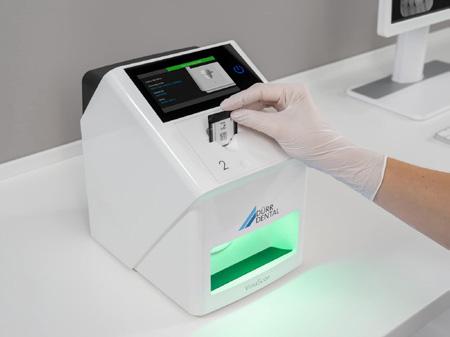
• Ideal chairside appliance
• LAN interface
• Quick and easy scanning

23 henryschein.co.nz
Vistascan Mini View 2.0
EQUIPMENT
EQUIPMENT IS IN OUR DNA
At Henry Schein, equipment is in our DNA! We have an enviable selection of capital equipment from four of the world’s leading manufacturers: A-dec, KaVo, Morita and Planmeca.
A wide range enables us to be flexible in meeting your needs. For example, if you’re looking to have a suite of equipment, all from the one ecosystem, Planmeca is a great choice. The award winning Finnish brand offers stylish Compact i chairs, intraoral and extraoral video imaging, Promax 2D and 3D X-ray, CAD/CAM mills and printers. This system is grounded by Planmeca’s fully integrated and powerful Romexis 6 software.
We also offer premium Japanese quality and reliability. Morita equipment looks and feels bespoke in a mass-produced world. On closer look you’ll find Morita are the quiet achievers: their endodontic systems appear on other leading brands, and their 3D imaging with the X800 is unparalleled. Add Morita to your list if you’re seeking equipment that has that tangible feel of quality.

KaVo represents the best in German engineering, with all their treatment units and handpieces manufactured in Biberach, located between the river Danube and Lake Constance. KaVo’s 100 years of production heritage is evident, combining tradition and innovation as exemplified in the new KaVo uniQa. KaVo’s proven ergonomics and intelligent features may well be the answer to improving your dental chair productivity with effortless functionality.
Our most recent edition is A-dec, renowned for reliable and straight forward solutions for the busy practice. Proudly manufactured in Oregon, A-dec is the undisputed champion of the American dental manufacturing industry. With A-dec we can adapt elegant solutions to specifically meet the requirements of your practice with legendary dependability.
In selecting Henry Schein, our relationship with your practice is underpinned as New Zealand’s largest dental supplier. Our goal is to be your trusted partner providing a one stop shop for all your dental needs, no matter the size or focus of your practice.
Our equipment support is made up of a dedicated team from Warehouse Operations to our highly trained Sales Specialists through to our ‘on the tools’ Aftersales Support crew. Our in-house Aftersales Team also work in conjunction with our diverse network of manufacturer approved agents to provide you nationwide service and support.
When speaking to our sales team, you’ll find our approach quite different. We ask how we can help you, and we listen for the answer. Henry Schein’s comprehensive range allows us to tailor a solution that meets your preferences, and the unique demands of your practice. Our family of brands can be combined to design a package that optimises your working style.
Our new Auckland showroom gives the experience of attending a mini exhibition with multiple brand choices side by side under the one roof. Infection Control, Dental Chairs or X-ray - our showroom is a great hub to compare products or systems with our team of experts available to assist you.
If it’s CAD/CAM you are interested in, we have a fully functioning lab onsite that demonstrates a workflow of the top brand scanners, mills and 3D printers. We’re always looking at the big picture and how we can best support the entire practice. Bundling solutions is our forte and helps us deliver maximum value to our customers: we encourage you to take advantage of this capability.
24 0800 808 855
EQUIPMENT
We invite you to make an appointment with one of our Equipment Specialists, or perhaps a confidential practice planning session with both your Equipment Specialist and Territory Manager.


Reach out to one of our team directly or alternatively check out the Henry Schein Equipment Website and contact us via the email enquiry form. Let us know...’How we can help you?’



https://henryscheinequipment.co.nz
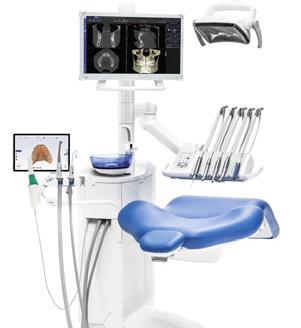
25 henryschein.co.nz EQUIPMENT
STEPS INTO STERI
The procedures required to prepare a contaminated reusable device ready for its intended use involve several steps. Known as instrument reprocessing, these steps follow an orderly flow from cleaning through to sterilisation and storage.

In our ‘Steps into Steri’ series, we have discussed Step 1 - receiving, cleaning, and decontamination, and Step 2 – Preparation and Packaging. Now we are ready for Step 3 - Sterilisation. At this stage, our instruments are clean, dry, packaged, and ready for the steriliser.

Steam sterilisation, also known as autoclaving, is a widely used and reliable method to render an item free of all forms of viable microorganisms. Steam is used, as it enhances the ability of heat and reduces the time and temperature required to denature or coagulate proteins in the microorganisms.
For this to happen, steam sterilisation relies on four parameters - steam, pressure, temperature, and time. These parameters can be adjusted to sterilise different types of loads.
B-Class Sterilisers (ST-M-BCLA17) are recognised as being able to achieve sterility with various styles of solid or hollow instruments. Sterilisation of hollow items, such as handpieces and triplex syringes, requires special attention to ensure that the steam can penetrate and reach all surfaces of the device, including the narrow lumens.
Before the first active load is processed for the day, the four parameters must be tested to ensure that sterilisation has been achieved.
A Vacuum Leak Test (VT) is performed to ensure that the chamber is properly sealed and that no leaks are present. This test will show the integrity of the door seal for example. A high leak rate could mean that the door seal is damaged and may need replacing (ST-2MOC-0011-K)
The vacuum leak test is run every day unless your steriliser incorporates an automatic air leak detection function, then it is performed weekly.
Air Removal and Steam Penetration Tests must be performed daily on vacuum-assisted steam sterilisers. A process challenge device (PCD), also known as a Helix Test (HS-9008649), verifies that the steriliser has effectively removed all the air from the chamber, therefore allowing steam to penetrate all surfaces of the items being sterilised. If any air remains it can create pockets where steam cannot reach. If any part of the item is not exposed to steam, it can lead to incomplete sterilisation. Daily testing identifies any issues before they become major problems.
In loads that contain porous items, air removal and steam penetration become more challenging. Porous loads, such as textiles, contain air pockets that can prevent steam from effectively penetrating the load. A Bowie-Dick-type testing device (HS-9008646) provides the challenge required to assess the air removal and steam penetration that is necessary for porous loads.
26 0800 808 855
INFECTION CONTROL
STEP 3 - STERILISATION
1 2 3 4
LOADING
A steam steriliser can only work effectively if steam can circulate freely and touch every surface of every instrument. Crowded, densely packed items touching each other, will inhibit steam penetration and sterility of those items. Load the items into the chamber in a way that ensures that they are evenly spaced and that there is adequate room for steam to circulate around them. When loading instruments that are not in pouches or wrap, a chemical indicator (MJ-S106103500S) must be placed in each loading tray to be processed as a visual check that the items have been sterilised.
DRYING
At the end of the steam sterilisation process, items should be dry. Wet packs and wicking can create an environment in which bacteria can grow, and this can lead to the contamination of sterilised items. There is also a chance of instruments corroding, and puncturing or tearing of packs when they are still wet. In a steam steriliser that does not have a drying cycle, only unwrapped items may be processed. When unloading the chamber, visually inspect each package. Look for any instruments that may have penetrated through the packaging, or seals on pouches that may have failed. Make sure the package is dry and that all chemical indicators’ have changed colour, as this shows that the required parameters have been achieved. Trays of instruments and wrapped items removed from the steriliser should be placed on racks and not directly on the bench to allow air to circulate. This prevents water condensation from occurring either around or inside the cooling packages.
VALIDATION
There are various qualification tests to ensure that the steam steriliser is installed properly, operates correctly, and can consistently achieve the required sterilisation conditions. Below is a brief explanation of each of the qualification tests for steam sterilisers:
Installation Qualification (IQ): ensures that the steriliser is installed properly according to the manufacturer’s specifications. It includes verifying that the steriliser is placed in the correct location, that all necessary utilities are properly connected, and that the required documentation is in place.
Operational Qualification (OQ): This includes testing that all the controls and sensors are working correctly, that the cycle parameters are within the specified range, and that the steriliser can consistently achieve the required sterilisation conditions.

Performance Qualification (PQ): This qualification evaluates the overall performance of the steriliser under realistic conditions. The prerequisites for PQ are successful IQ and OQ tests. It includes testing with challenging loads that represent the range of items to be
sterilised, to ensure sterilisation of all types of loads. It also includes monitoring the process to ensure that it is consistent, and that the steriliser is performing within the required parameters.

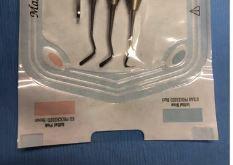

The 3M™ Attest™ Mini Auto-reader (MD-490M) with biological indicators (spore tests (MD-1492V)) provide sterilisation monitoring results in just 24 minutes. Record the testing results in a validation log in your policy and procedure manual. If the results do not meet the established protocol, corrective actions should be taken, and the process should be revalidated.


REFERENCES
ADA, https://www.ada.org.au/Dental-Professionals/Publications/Infection-Control
27 henryschein.co.nz INFECTION CONTROL
only.
NZ Dental Council, https://www.dcnz.org.nz/assets/Uploads/Consultations/2015 The products listed are provided as suggestions
MAINTAINING YOUR STATIM STERILISER
Keeping the STATIM cassette clean is good clinical practice and assists in the proper functioning of the unit. It is recommended that the interior surface be cleaned at least twice a week.
Cleaning the inside of your cassette is very important if you regularly sterilise lubricated instruments. Use dishwashing soap or a mild detergent that does not contain chlorine. Scrub the inside of the cassette with a cleaning pad designed for use with Teflon™ coated surfaces. Rinse thoroughly with water to remove all traces of the detergent.
Coating the entire inside surface of the cassette with STAT-DRI drying agent induces water to form an even coat on the inside surface, without beading. The water in contact with the hot cassette surfaces also evaporates much more efficiently.
Spotting is minimized and instruments dry much better. STAT-DRI should be applied every 10 cycles and after every cassette cleaning. Some offices use it as often as every morning. Spray it on the inside surfaces of the cassette and use a paper towel or gloved hand to spread it around, so that you have covered the inside of the cassette - top and bottom.
STAT-DRI Plus with sprayer is available from Henry Schein, with item code SCI-2OZPLUS.

To ensure optimum performance of your STATIM cassette steriliser, change the cassette seal every 500 cycles or every six months, whichever comes first. Do not wait until there is steam pouring out of the cassette before replacing the seal. Item codes for replacement seals are STATIM 2000 - SCI-01100028S and STATIM 5000 - SCI01101649S
During the first cycle after changing the seal, steam may appear between the lid and the tray as the seal seats. If this persists, remove the cassette and check that the seal is correctly installed.
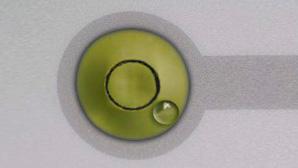

For both the 2000 & 5000 models, make sure that the port inside the cassette back left corner, does not have any debris.
The bubble on the front right corner of the STATIM should be in the 4 to 5 o’clock position, NOT in the centre of the circle. This allows any water to flow to the back left corner of the cassette where it is vented out. This will allow the water to flow to the exhaust port much easier. Use the STATIM’s three adjustable feet to change the level, with the front right leg extended fully.
Check that there are not any kinks in the exhaust tubing running from the back of the STATIM to the waste bottle. Kinks in this tubing will significantly reduce the STATIM’s ability to dry instruments. If there is a kink that cannot be straightened out, replace the tubing with SCI-01100204S.

28 0800 808 855
INFECTION CONTROL
It is very important to change the microbiological air filter on the back of the STATIM 2000S & 5000S every 6 months, or at least every time you change the cassette seal. Some older STATIM units do not have this filter.
To verify whether your STATIM 2000 or 5000 has this filter, look at the back of the machine. If there is a rectangular clear plastic filter with 2 grey hoses coming off it, your machine has the filter. The microbiological air filter is an extremely fine filter.
It is fine enough that it may be significantly plugged up but may not look dirty. Oftentimes, offices have never changed these filters, which results in poor drying capabilities.
To order a replacement STATIM Biological Filter use item code SCI-01102119S

On the STATIM 2000 there is also an air filter on the air compressor. This is a doughnut-shaped filter that should be replaced every six months. Part # SCI-01100207S. It is located at the rear of the machine, under the round silver cap with a screw in the middle of it. Simply remove the screw to access the filter.
The key to optimal drying in any steriliser is to load it according to the manufacturer’s instructions. Through a series of tests, maximum load weights are determined at manufacture, and the values are included in the operator’s manual. To complete a successful cycle with dry loads, special care must be taken when loading your instruments. It’s important to note that drying cycles have a pre-set time that is determined before the cycle begins. If there are instances when water droplets are present at the end of the cycle, then the operator should increase the pre-set drying time.
For proper loading of your STATIM, place instruments that are in pouches, paper side down. This allows water to “wick” out through the paper and improves drying. Pouched instruments in the STATIM 5000 should be placed on the STAT-DRI Plates (SCI-01103935) to ensure the heat from the plates helps evaporate any moisture in the pouches.

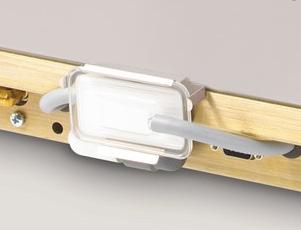
Lay the pouches’ paper side towards the plate.
The STATIM needs airflow through the cassette to dry the instruments, therefore you must use the flat wire rack inside of the STATIM cassette.
For optimum drying, make sure that the feet on the rack are facing down to give the maximum amount of airflow under the instruments.
Do not overstuff the cassette.
29 henryschein.co.nz
How to change your STATIM cassette seal
INFECTION CONTROL
Hints and tips for general STATIM maintenance
To ensure trouble-free performance, operators must follow this preventative maintenance schedule.
Cassette
Water Reservoir
• May be cleaned daily with washing up liquid and a scrub pad. Then rinse with clean water before use
• It is advisable to replace water daily. Always use steam distilled water
• For Ophthalmic use, drain at the end of every workday, leave empty, and refill at the start of the next workday
Waste Bottle
• Empty the waste bottle every time you refill the water reservoir
• Fill the bottle with water, up to the MIN line marking. You may also add some chlorine-free disinfectant
Cassette
STAT-DRI Plus SCI-2OZPLUS

Water Reservoir Filter* SCI-01109300S


Biological Filter SCI-01102119S

Cassette Seal SCI-01100028S (2000S)

SCI-01101649S (5000S)
Compressor Filter ** (Statim 2000S only)
SCI-01100207S (2000S)
SCI-01101652S (5000S prior to 2005)
• Wash the interior of the cassette with dishwashing soap or a mild detergent that does not contain chlorine
• Scrub the inside with a soft cleaning pad

• After removing all traces of the detergent, treat interior surfaces of the cassette with the Stat-Dri Plus drying agent to enhance the drying process.
• Check the water reservoir filter every week and clean if necessary. (Replace only if necessary)
• Replace every 500 cycles or six months (whichever is first) or it will affect airflow and drying performance.Call for service if wet.
• Replace every 500 cycles or six months (whichever is first), or whenever necessary
• Replace every 500 cycles or six months (whichever is first)
30 0800 808 855 INFECTION CONTROL the Daily Weekly Every
6 months
* This filter is fitted to Statim autoclaves manufactured from October 2006 only. It can be retrofitted to older models by ordering 01-101783S. ** Also Statim 5000S units manufactured before 2005.
TEAR OUT
RAPID STERILISATION VERIFICATION
THE WAIT IS OVER
Biological indicators, or spore tests, are the most accepted method for monitoring the sterilisation process. A biological indicator (BI) test monitors the killing of a large population of resistant microorganisms and provides assurance to a dental practice that their sterilisation cycle parameters have been met.
BI testing of sterilisers in dental offices can take 24 hours or more for results to be obtained.
During that wait time, a malfunctioning steriliser could be used to process instruments used on patients. With the 3M™ Attest™ Mini Auto-reader, sterilisation monitoring results are available in just 24 minutes. Dental teams no longer need to have extensive wait times to confirm test results.

Another great feature of the 3M Attest™ Mini Autoreader is the App. The 3M Attest™ ‘Connect App’ is a mobile application that is designed to work with the 3M Attest™ Mini Auto-reader.
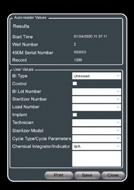

The app allows users to wirelessly connect their mobile devices to the Auto-reader, providing real-time monitoring and tracking of sterilisation processes. The app allows users to monitor the progress of sterilisation cycles, providing alerts when cycles are complete or if there are any issues during the cycle. It will send notifications to users when new test results are available, allowing them to quickly respond to any issues that may arise.
The small, easy-to-use device is designed to incubate, read and interpret the results in just 24 minutes. An Attest™ BI contains bacterial spores that are resistant to the sterilisation process being monitored. If the sterilisation process is effective, the spores should be killed, resulting in a negative test result.
The 3M Attest™ Mini Auto-reader works by using fluorescent technology to detect the presence or absence of bacterial growth in the test. After the test is performed, it is loaded into the auto-reader and incubated. Each BI vial contains a fluorescent marker. If there is bacterial growth in the BI, the fluorescent marker will be activated and produce fluorescence.


The Auto-reader then interprets the fluorescence signal and provides a clear result of either “positive” or “negative” for the test. This automated process helps to reduce the risk of human error and provides a more accurate, reliable and fast interpretation of test results.
The app records all test results and cycle information, allowing users to track the performance of their sterilisation processes over time. This data can be used to identify trends, track compliance with regulatory requirements, and help ensure patient safety.
Overall, the 3M Attest™ Connect app helps dental offices improve the efficiency and accuracy of their sterilisation processes by providing real-time monitoring, record-keeping, and remote access to sterilisation data.

31 henryschein.co.nz
INFECTION CONTROL
THERMAL WASHER DISINFECTORS
THE UPTAKE CONTINUES TO GROW
The uptake of automated instrument cleaning using thermal washer disinfector units continues to increase as dental practices update their infection control workflows and equipment. The trend is as much driven by the need to comply with a Standards-driven push to move away from manual instrument cleaning as it is to increase efficiency and make better use of valuable human resources.
We spoke to Jim Owen from MOCOM Australia about this growing trend in infection control solutions and why installing a washer disinfector is a good idea.

Q. So why are washer disinfector units becoming the new normal in dental sterilisation rooms?
A. I think the big driver for installing washer disinfectors in 2023 will continue to be as a way of future proofing your practice. The new draft standard AS 5369:2021, which will replace AS/NZS4187 and AS/NZS4815, reiterates the need to move away from manual instrument cleaning so we’re only going to see more and more interest in automated systems.
There are also myriad benefits to using a washer disinfector over manual cleaning. It’s a validated process so you know its cleaning effectively. It allows for better use of staff time. There is significantly less risk of sharps injuries due to reduced handling. Many practices are on an efficiency drive so for a staff member to be able to load the washer disinfector and then move on to other duties while the instruments are automatically cleaned has a multitude of benefits.
Q. Is a washer disinfector an alternative to an ultrasonic bath?

A It’s a better alternative. A lot of practices do use ultrasonic baths to assist in instrument cleaning but the fact remains that you still need to manually handle the instruments. You still need to rinse the instruments afterwards and you still need to dry the instruments before
sterilisation. And you need to drain the chemicals out of the bath.
If you’re short on space, we have a bench top washer disinfector (Mocom H10 Tethys) that completely automates that process and for larger clinics, the under-bench models offer even greater productivity. You load the dirty instruments, and the unit does the rest.
Q. Can you clean handpieces in washer disinfectors?

A. The short answer is yes you can. In our underbench units, there’s an accessory for this. The handpieces fit into a silicon holder that allows water and chemicals to be “pushed” through the handpiece mechanism to remove any bioburden. It’s one size fits all handpieces.
Our bench top unit, the Tethys H10, is also now able to process handpieces using an accessory.
Up until recently, you couldn’t process handpieces in the H10 because it uses ultrasonics during the washing phase. And as we know, you can’t put rotary instruments in an ultrasonic bath. With the new firmware update, however, it enables the ultrasonic function to be turned off and with the addition of the handpiece accessory, you can now process up to six handpieces at a time.
In both cases, once removed, the handpieces should be lubricated prior to sterilisation.
It is of course important for practices to clean their handpieces internally as well as lubricating them and we often see this first step overlooked.
32 0800 808 855
INFECTION CONTROL
Q. What about instrument cassettes?
A. Instrument cassettes are actually perfect for use in our washer disinfectors and mitigate the risks of sharps injury even further. Instruments can remain in the cassettes during cleaning and drying in the washer disinfector and once completed, wrapped or bagged for sterilisation.
If practices are utilising instrument cassettes, like HuFriedy’s IMS, MOCOM has two accessory racks that allow up to 12 of the very large cassettes to be processed at a time in our full-size under-bench washer disinfector.
Using cassettes has also been shown to save time and increase efficiency. Instruments are loaded into the cassette chairside after use and closed for transport to the sterilisation area. The entire cassette is placed in the washer disinfector unopened.
The instruments inside are cleaned and disinfected and dried at the end of the cycle. After inspection, the cassette is then bagged or wrapped and placed into an autoclave for steam sterilisation. The instruments in the cassette are then ready for patient use.
So, the instruments inside are never misplaced, dropped or damaged and risks of a sharps injury is negligible. So whereas using a washer disinfector alone increases your efficiency considerably, when used in conjunction with a cassette system, the gains are even greater.
Q. Do the instrument cassettes fit in the sterilisers?
A. We have multiple chamber racks available for the sterilisers as well. As cassette systems have become larger and more popular, having sterilisers that can accommodate these is obviously important.
And sometimes you find with different brands of sterilisers that the standard chamber rack doesn’t accommodate cassettes very well. At MOCOM we have a couple of options that basically utilise the width of the round chamber better so you can get those bigger cassettes in.
We also have what we call a modular tray rack where the shelves can be adjusted to the different heights of the cassettes. And we also have three chamber sizes available with the 28-litre model being fairly unique for bench top dental sterilisers. Its larger diameter obviously allows you to fit more in but also accommodates larger instrument cassettes with ease.
Q. How long does the washer disinfector take to process a load?
A. A full cycle with our largest D60 under-bench model utilising three-phase power - which includes pre-rinse, wash, thermal disinfecting and drying - takes around 90 minutes. There are also shorter cycles.
The D60 has 16 cycles to select from and some of the shorter cycles don’t include the pre-rinse. We tend to recommend using the full cycle because the Standard says that if you’re using a washer disinfector, you should be using a cycle with a pre-rinse.
Q. When you say a validated process, what does that mean?
A. It means that you’re getting the same cleaning result every time because a technician has validated that the process is successful. It means the unit has been tested to ensure it is cleaning thoroughly, time after time. Soil tests and process challenge devices should also be used at regular intervals per guidelines.

Q. How are the chemicals dispensed?
A. Part of the validated process is the automated dispensing of chemicals to ensure the correct amounts are used. There is a chemical cleaner and an acid neutralizer. There are two 5-litre bottles that sit side-byside next to the machine, normally inside a cupboard.
Q. Do washer disinfectors record cycle data?
A. The units do record cycle data - disinfection level and how long it’s disinfected for and at what temperature. The unit can send cycle data to a computer and then this can be read with the software provided. There’s also an option for an external printer to print cycle data. Like sterilisers, you’re meant to record this information with thermal disinfectors as well.
Q. Any final words of advice?
A. There’s been a lot of talk about the use of washer disinfectors becoming mandatory. It’s already recommended in the Standard that you should always be using a washer disinfector where possible, unless the instruments cannot withstand the rigors of the cleaning process.
So installing a washer disinfector the next time you update your sterilisation area is future proofing your practice against any changes that may occur. It will also deliver a range of other benefits to your practice that will pay for itself time and again.
33 henryschein.co.nz
© 2023. Originally published in Australasian Dental Practice Vol. 34 No 1. January/February 2023. Reprinted with permission. INFECTION CONTROL
INFECTION PREVENTION & CONTROL IN DENTAL SUCTION LINES
As part of a local team of practicing and former dental service technicians (including founder Bill Clark), we at Cattani Australasia completely understand the risks of infection exposure when it comes to dental suction systems.

As a result, this drives us to focus on a holistic infection prevention and control approach in delivering worldclass dental air.
“The Cattani legacy is the embodiment of where our quality comes from, and what we stand for today. From developing large installation modular solutions through to the development of disinfection products for dental suction to mitigate risks of infection to dental professionals, patients and maintenance staff, Cattani Australasia has been painstakingly refining precision performance to keep your surgery operating safely for more than 35 years in Australia.”
Mark Humphries
Your health and safety obligations
Those who operate in the dental health workspace are not only responsible for providing a safe environment where dental health care is being delivered, but also for mitigating the risks of infection for everyone who uses or supports the operation of dental suction systems.
As patients and staff members that operate within this area are generally front of mind when it comes to infection prevention and control for dental suction
systems, the duty of care extends to all the other individuals that may come in contact with the system.
This may include anyone that may enter the plant room. Keep in mind that suction systems within the plant room will undergo weekly and annual routine maintenance as well as potential irregular maintenance, including the collection of amalgam retention containers for recycling purposes.
Differentiating products to be used on medical devices
As Cattani dental suction systems are medical devices, disinfectants intended to be used on Cattani plant equipment are heavily regulated. Cleaners intended to be used on medical devices that do not claim to be a device disinfectant or sterilant are regulated as Class I medical devices.
Liquids, sprays, wipes, and aerosols intended to be used on medical devices that make disinfectant or sterilant claims are regulated as Class IIb medical devices. Puli-Jet Gentle 2.0 is an example of a Medical Device Class IIb, registered an antimicrobial solution made to disinfect dental medical devices.

Infection prevention and control considerations:
• Patients
• Staff who use the suction system
• Staff and contractors who perform system maintenance on your plant room equipment
• Amalgam recycling contractors
34 0800 808 855
INFECTION CONTROL
Details that matter
• Non-foaming
• Ease of use
• Phenol FREE
• Aldehyde FREE
• Disinfects and cleans

• One disinfectant, one dilution, once-a-day
Dental suction disinfection and its impact on suction performance

To ensure optimal suction performance at a dental surgery, it is crucial to have extensive forethought and planning. From the gradient of the pipelines to the distance between the suction unit and chair, through to selecting the appropriate solution used for disinfection, correct suction maintenance is an important part of keeping your surgery operating at its finest.
Whilst it is common practice to disinfect suction lines at the end of each working day, it is also wise to manage the potential of foam emerging within the dental suction system.
Foam management is critical as it can be pulled into the suction motors which can cause damage or even equipment failure if repeated over time, as this component was designed to always remain dry.
Within the dental suction system, foam could occur in several ways including:
a) certain dental treatments that have a large amount of dense liquids such as blood, mucus, and thick saliva; or
b) using unsuitable detergents and cleaners containing ingredients that produce foam.
To address this, there are Antifoaming Disinfectant Tablets to complement end-of-day suction maintenance, for clinics that want an extra level of disinfection throughout the treatment day and want the added benefit of managing foam to protect suction performance.
Conclusion
Dental suction system maintenance is about protecting your business asset, as much as infection prevention and control for all individuals that may come into contact with the dental suction system. Only choose the approved disinfectant that meets your dental practice infection prevention and control requirements and is suitable for use with your dental suction system.
35 henryschein.co.nz INFECTION CONTROL CLICK HERE
View Cattani Online
MARK HUMPHRIES Group Technical Manager Cattani Australasia
HARMONY ERGONOMIC SCALERS AND CURETTES
It’s no secret that most dental professionals experience fatigue, pain, and discomfort of the hand, wrist, or arm on a daily basis. But since the COVID pandemic surfaced, many dentists and hygienists have been forced to switch from power instruments to hand instruments, which often exacerbates any previous work-related discomfort from repetitive motion. “I was getting pain in my thumb joint from having to mostly hand scale since COVID,” described Deborah Deal, CRDH.
Hoping to relieve fatigue and discomfort for clinicians, Hu-Friedy developed an innovative and ergonomic hand-scaling solution, the new Harmony Ergonomic Scalers and Curettes. Combining Hu-Friedy’s proprietary TrueFit technology with its EverEdge 2.0 blade sharpness technology, the Harmony instruments provide an ergonomic solution that reduces a clinician’s pinch force grasp, improves grip, and requires less pressure on the tooth - perhaps extending the length of a dental professional’s career.
For Deal, and many other dentists and hygienists who evaluated the Harmony scalers and curettes for DPS, these instruments provide much-needed relief from daily discomfort. “The Harmony design allows me to use a lighter grip to remove deposits, and it is less stressful on my finger joints,” Deal stated.
TrueFit Technology & Reduced Hand Fatigue
The Harmony ergonomic scalers and curettes are designed with Hu-Friedy’s proprietary TrueFit technology, a sensorbased system derived by measuring millions of data points for pinch force in the finger and pressure applied to the tooth when scaling.
Reducing pinch force by up to 65% and requiring less
pressure to the tooth when scaling, Hu-Friedy says the instrument’s design helps to alleviate hand fatigue and injury risk due to repetitive motion. With EverEdge 2.0 technology, the working ends of the Harmony instruments are 72% sharper than others, according to Hu-Friedy, enabling calculus removal with less pressure and biomechanical stress on fingers and hands.
“The ergonomics [of the Harmony instrument] helped remove deposits easier and with less hand fatigue,” said Mary Aigeldinger, RDH, and hygienist Kim Attanasi agreed. “The design allowed me to scale without using too much pressure, which, in turn, prevented fatigue.” For Maureen Curran, RDH, “the instrument allows for lighter grasp, therefore reducing hand fatigue,” and Michaela Popa, DMD, said the instruments are very sturdy, precise, and cause less hand fatigue.
“Due to COVID, many patients have neglected their oral health; a majority had some type of periodontal disease and subgingival calculus. Hand and wrist fatigue has been a major problem,” said Lydia Pope, RDH. “This scaler worked effortlessly. I used much less pressure when scaling, and it reduced my hand and wrist fatigue,” she explained.
“I really like the design of the scaler combined with the EverEdge 2.0 technology,” said Jennifer Porter, RDH.


INSTRUMENTS
36
“I used much less pressure when scaling, and tactile sensitivity was off the charts.”
Lydia Pope, RDH New Lenox, IL
“Angled loweranterior teeth were a breeze to clean without pinching my handle firmly.”
Maureen Curran, RDH Norwalk, CT
“I really enjoyed the feel/grip of the new handle design and liked the sharpness of the blade.”
Jennifer Porter, RDH Jacksonville, FL
PRACTICE OPERATIONS SOLUTIONS
“The instrument’s design allowed me to scale without using too much pressure, which, in turn, prevented fatigue.”
Kim Attanasi PhD, MS, RDH Staten Island, NY
“The instrument’s design allowed me to scale without using too much pressure, which, in turn, prevented fatigue.”
Kim Attanasi PhD, MS, RDH Staten Island, NY
Grasp/Grip and Tactile Sensitivity
The Harmony handle easily adapts to each clinician’s individual grasp, while the optimised shape and extended silicone grip are well balanced, providing a secure and nimble grasp with optimal tactile sensitivity.
“I like the shape and feel in my hand that enables a light grip,” said Deal, and Lauren Dennis, RDH, said, “The new ergonomic shape compared to the original handle provides more comfort, a noticeable difference in pinch force reduction.”
scaler worked effortlessly. I used much less pressure when scaling, and it reduced my hand and wrist fatigue,” she explained. “I really like the design of the scaler combined with the EverEdge 2.0 technology,” said Jennifer Porter, RDH.
Grasp/Grip and Tactile Sensitivity
Pamela Emard, RDH, stated, “At the end of the day when my hands are beginning to fatigue, I didn’t have to worry about the instrument slipping from my grasp.”
The Harmony handle easily adapts to each clinician’s individual grasp, while the optimised shape and extended silicone grip are well balanced, providing a secure and nimble grasp with optimal tactile sensitivity. “I like the shape and feel in my hand that enables a light grip,” said Deal, and Lauren Dennis, RDH, said, “The new ergonomic shape compared to the original handle provides more comfort, a noticeable difference in pinch force reduction.”
Curran said, “Angled lower anterior teeth from the lingual were a breeze to clean without pinching my handle firmly.”
Pope said the handle’s shape allowed her to apply a looser, more relaxed grip while removing deposits, and it was easy to feel and remove subgingival calculus. “Tactile sensitivity was off the charts,” she added.
Increased Efficiency
Pamela Emard, RDH, stated, “At the end of the day when my hands are beginning to fatigue, I didn’t have to worry about the instrument slipping from my grasp.” Curran said, “Angled lower anterior teeth from the lingual were a breeze to clean without pinching my handle firmly.” Pope said the handle’s shape allowed her to apply a looser, more relaxed grip while removing deposits, and it was easy to feel and remove subgingival calculus. “Tactile sensitivity was off the charts,” she added.
Overall Satisfaction
Noting that proper instrumentation “makes our jobs more efficient with less stress,” Curran said, “I really like the overall Harmony design and plan to order more.”
The Harmony design allowed Curran “to save time during appointments and have less aches at the end of the day,” and Aigeldinger said she wanted to use the instrument frequently, especially when a patient had heavy, hard deposits.
Overall Satisfaction
Pope said she likes everything about the Harmony instruments and “wouldn’t change a thing,” while Inman concluded, “I am already recommending these instruments and am planning on ordering more.”
Noting that proper instrumentation “makes our jobs more efficient
with less stress,” Curran said, “I really like the overall Harmony design and plan to order more.” Pope said she likes everything about the Harmony instruments and “wouldn’t change a thing,” while Inman concluded, “I am already recommending these instruments and am planning on ordering more.”
SNAPSHOT
Increased Efficiency
Harmony Ergonomic Scalers and Curettes “make my job easier and quicker!” exclaimed Laura Inman, RDH, and hygienist Brooke McCorvey said she “loves the way it adapts. Ease and efficiency are pretty awesome.”
Pope used a Harmony scaler on subgingival calculus and said, “Less strokes were used per tooth. Calculus was removed with ease, [and there was] less pain and discomfort for the patient.”
Harmony Ergonomic Scalers and Curettes “make my job easier and quicker!” exclaimed Laura Inman, RDH, and hygienist Brooke McCorvey said she “loves the way it adapts. Ease and efficiency are pretty awesome.” Pope used a Harmony scaler on subgingival calculus and said, “Less strokes were used per tooth. Calculus was removed with ease, [and there was] less pain and discomfort for the patient.”
The Harmony design allowed Curran “to save time during appointments and have less aches at the end of the day,” and Aigeldinger said she wanted to use the instrument frequently, especially when a patient had heavy, hard deposits.
Article from Dental Product Shopper March 2022.
37 henryschein.co.nz INSTRUMENTS
0800 808 855 28
HARMONY ERGONOMIC SCALERS AND CURETTES FINAL SCORE AVERAGE OF SECTIONS A AND B
of
(EverEdge
and nimble grasp with extended
Reduction in pressure applied to tooth Pinch force reduction SECTION B OVERALL SATISFACTION SECTION A AVERAGE Balance Tactile sensitivity Overall comfort for clinician
PRODUCT EVALUATION
Sharpness
blade
2.0) Secure
silicone grips
PROTECTING COMPLEX RESTORATIVE DENTAL WORK
A considerable amount of time, effort and money goes into complex restorative work including crowns or bridges. Patients, often after past caries experience, and other riskrelated behaviors such as poor oral hygiene or a sugary diet, end up needing a substantial amount of dental work to stabilize their oral health. While many of the risk factors which have caused the dental disease may have been addressed prior to commencing complex restorations, the work doesn’t end there.
Especially for older patients, as their oral environment changes, maintaining this complex restorative work can be challenging. Difficulties include home care and sub-gingival restorative margins, the risk of root caries associated with exposed roots caused by gingival recession and, for some patients, reduced manual dexterity that negatively impacts their ability to deliver pristine oral hygiene. They also may have never known how best to care for their teeth in the first place! These can all lead to the dreaded secondary caries which can be difficult to treat and can ultimately end in tooth-loss. This is clearly not an outcome that is desired, and your patient has already invested a lot of time and money to improve their oral health.
So how can we help these patients to protect their complex work? The following are suggested and recommended by leading dental authorities1,2,3
1. Give detailed oral hygiene coaching, including how to maintain oral health around difficult restorative margins, by performing twice-daily brushing and using interdental cleaning aids daily, such as floss or interdental brushes;
2. Consider recommending a high strength fluoride, for example Neutrafluor 5000 Plus*, which contains 5000 ppm fluoride (1.1% sodium fluoride). High fluoride toothpaste use in patients with an elevated risk of dental caries is recommended in the guidelines from the Australian Dental Association1., the American Dental Association2 and the International Caries Classification and Management System3;
3. In addition, consider in-surgery application of 5% sodium fluoride varnish such as Duraphat Varnish^ for those who are at risk of dental caries;
4. The American College of Prosthodontics has also published Clinical Practice Guidelines for the Recall and Management of Tooth-borne restorations, which contains guidance and provides recommendations for the different types of complex restorative work your patient may have such as fixed prostheses and removable prostheses. This guidance is helpful both in terms of oral hygiene and products to recommend, but also the frequency of dental recall to monitor the restorative work both you and your patient have invested in.
Ensuring the long term success of complex dental work and protecting the patient’s investment will help to avoid having dissatisfied patients and improve their oral health for the future.
References
1. https://www.adelaide.edu.au/arcpoh/dperu/fluoride/Guidelines_ for_use_of_fluorides_in_Australia__update_2019.pdf
2. https://www.ada.org/resources/research/science-and-researchinstitute/evidence-based-dental-research/caries-managementclinical-practice-guidelines/evidence-based-clinical-practiceguideline-on-nhttps://www.iccms-web.com/uploads/ asset/59284654c0a6f822230100.pdfonrestorative-treatmentsfor-caries-lesions
3. https://www.iccms-web.com/uploads/ asset/59284654c0a6f822230100.pdf
*Neutrafluor 5000 Plus Toothpaste - Sodium Fluoride 11.05mg/g

Dental caries preventative for individuals at high risk for caries, when used as part of a preventative regimen recommended by a dental professional or doctor. Use daily in place of a regular toothpaste. Apply a thin ribbon of toothpaste to soft small toothbrush. Brush teeth thoroughly for 2 minutes and then spit out. For best results, refrain from eating, drinking or rinsing for 30 minutes. Not for use in patients with known allergies or hypersensitivity to any of the ingredients of Neutrafluor 5000. Allergic reactions have been rarely reported with the use of fluoride toothpastes.
^Duraphat Varnish - Sodium Fluoride 50mg/mL

Prevention of caries. Treatment of sensitive teeth. Not for use in patients with hypersensitivity to any ingredients in Duraphat, ulcerative gingivitis, stomatitis and bronchial asthma. Not for systemic treatment. Do not swallow. 33.8% ethanol content. Avoid use in pregnant or lactating women
Neutrafluor 5000 Plus (Restricted Medicine - NZ). Duraphat Varnish (Prescription Medicine -NZ). Please refer to the full product information before recommending. Available from Colgate-Palmolive upon request. Colgate-Palmolive Pty Ltd. 420 George St, Sydney, NSW AU. Colgate-Palmolive Ltd. 45 Knights Rd, Lower Hutt, NZ
38 0800 808 855
PREVENTATIVE
CONNECTED TOOTHBRUSHES
DO THEY HELP TO CONNECT THE DOTS?
Having the right toothbrush is key to successful oral hygiene. But actually, a toothbrush is only as good as the person using the brush.
No matter if patients use electric or manual toothbrushes, dental professionals should help coach their patients in their effective use. A recent development in this sector has been the use of interconnected apps which directly link with electric toothbrushes.
This correlates to the global trend of people being more health aware and using connected health technology in their everyday lives to track and improve everything from fitness to sleep.
The connected brush allows people to monitor the frequency, duration and coverage of brushing. This data can help dental professionals understand how a patient might be able to improve their oral hygiene.
The American Dental Association recently updated their Teledentistry policy to include apps that monitor brushing or other home care.
This study Connected Health App Improves Oral Health with Real-Time Education IADR Abstract Archives compares the benefits of brushing with and without the connected app. It found that people brushing with the connected app had significantly lower levels of plaque overall, and interproximally after 6 weeks. Using these apps can be a great way to instill good oral hygiene behaviors in your patients.
Gamification in healthcare is becoming increasingly popular in helping to improve healthy habits and incentivise good health outcomes for young and old - oral health is
no exception and these apps can help make learning how to brush correctly fun!
Colgate have recently launched a new fully connected electric toothbrush range named Pulse which helps the user improve their brushing habits. Most people miss 40% of their tooth surfaces when they brush*.

The Pulse Series 2 brush with connected APP can improve this coverage and the time spent brushing with 50% more plaque removal at the gum margin after brushing for 6 weeks compared to a non-connected electric toothbrush.
As well as gamification, these toothbrushes can also have reminders set to motivate and nudge your patients into other good oral health habits such as twice daily brushing, visiting the dentist and changing brush heads.
These next generation toothbrushes are a great way to help connect the dots of good at home oral health care.
*Based on tooth surface coverage data collected by the colgate connect app when brushing with a smart electric toothbrush
39 henryschein.co.nz
PREVENTATIVE
View on the Henry Schein Web Shop
Build Connection With Your Patients
Patient loyalty is essential to the success and growth of your practice. Engaging your patients has never been easier with our suite of patient communication tools. Reach your patients when and where it matters to them, to drive the success of your practice. Visit
Minimise
Increase
SOFTWARE
revenue and ROI Creating a more personal connection with your patients ensures you maximise earning potential in your practice and focus your marketing in areas that deliver the best impact.
missed appointments
With Automated Recall Manager you can schedule and automate recalls and reduce the risk of patients missing appointments. Save your team time and ensure patients get the treatment they need.
Deliver tailored communications Campaign+ allows you to generate targeted communications and marketing for your patients. Keep them up to date on new treatments and other services that can improve their oral health.
exactdental.co.nz and discover how our software can help you deliver incredible patient experiences.
on the
of Excellence
Begin your journey
Path
today.
C M Y CM MY CY CMY K EXACT_Full Page_Building_Connections (1).pdf 2 17/04/2023 09:17 0800 808 855 info@henryschein.co.nz henryschein.co.nz Prices are effective from 01/07/2023 to 30/9/2023 and exclude GST and freight (E&OE). While every effort has been made to ensure their accuracy, circumstances beyond our control including variances in supply costs and foreign exchange rates may affect our customer price. Please log-in to your Henry Schein online account to confirm the current price prior to placing an order. Prices or offers in this publication are not applicable to Government or Corporate Accounts. The term “Indent Only” refers to items that can be ordered offshore and supplied specifically to you at your request on a non-refundable/non-cancellable basis.


























































































































































